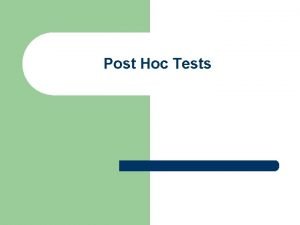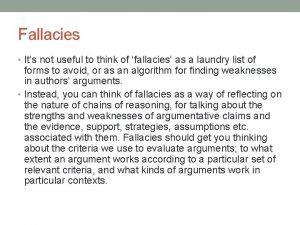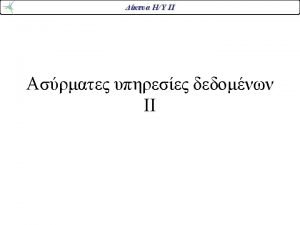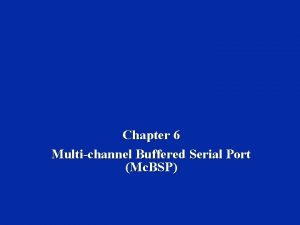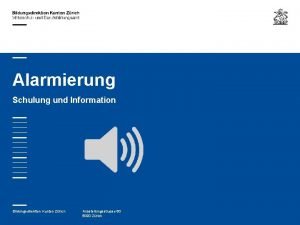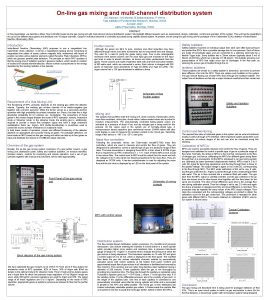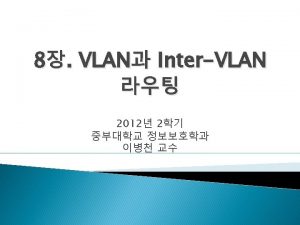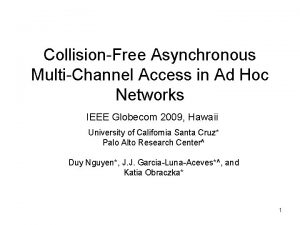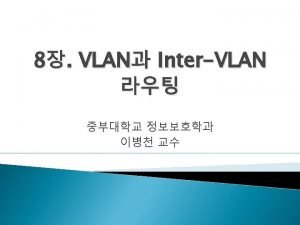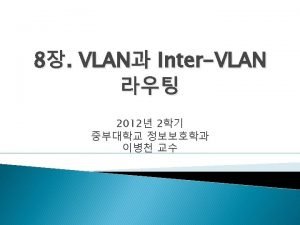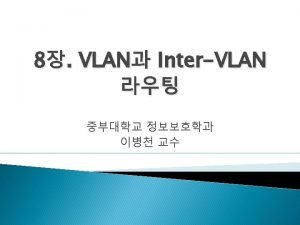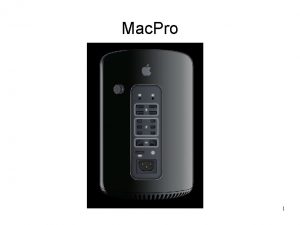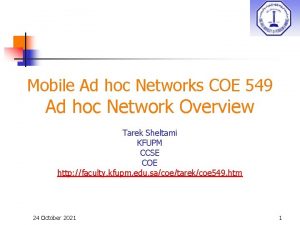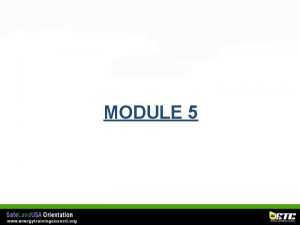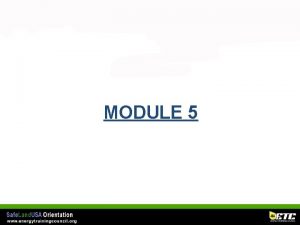MultiChannel MAC for Ad Hoc Networks Handling MultiChannel


























- Slides: 26

Multi-Channel MAC for Ad Hoc Networks: Handling Multi-Channel Hidden Terminals Using A Single Transceiver Jungmin So and Nitin Vaidya Modified and Presented by Yong Yang University of Illinois at Urbana-Champaign

Problem Statement • Utilizing multiple channels can improve throughput – Allow simultaneous transmissions 1 1 defer Single channel 2 Multiple Channels • Multiple Channels available in IEEE 802. 11 – 3 non-overlapping channels in 802. 11 b • But, 802. 11 MAC protocol is only for a single channel – Doesn’t work well due to Multi-channel Hidden Terminal Problem • Naïve method: a node has a transceiver for each channel

Overview • Goal: Design a MAC protocol that utilizes multiple channels to improve overall performance – Modify 802. 11 DCF to work in multi-channel environment • Constraint: Each node has only a single transceiver – Capable of listening to one channel at a time • MMAC (Multi-channel MAC) – Divide time into fixed-time interval using beacons – Have a small window at the start of each interval – Senders and receivers negotiate channels for this interval Common Channel A B Negotiate Channel Selected Channel RTS DATA Beacon CTS ACK

Multi-Channel Hidden Terminals • Consider the following naïve protocol – – – Each node has one transceiver One channel is dedicated for exchanging control msg Reserve channel as in IEEE 802. 11 DCF Sender indicates preferred channels in RTS Receiver selects a channel and includes it in CTS Sender and Receiver switch to the selected channel • This protocol is similar to DCA (Dynamic Channel assignment) [Wu 00 ISPAN] • RTS/CTS can’t solve Hidden Terminal Problem

Multi-Channel Hidden Terminals Time B A C D RTS(2, 3) Channel 1 Channel 2 Channel 3

Multi-Channel Hidden Terminals Time B A C D RTS(2, 3) CTS(2) Channel 1 Channel 2 Channel 3

Multi-Channel Hidden Terminals Time B A C D RTS(2, 3) CTS(2) DATA Channel 1 Channel 2 Channel 3

Multi-Channel Hidden Terminals Time B A D C RTS(2, 3) CTS(2) DATA RTS(2, 3) Channel 1 Channel 2 Channel 3

Multi-Channel Hidden Terminals Time B A D C RTS(2, 3) CTS(2) DATA RTS(2, 3) CTS(2) Channel 1 Channel 2 Channel 3

Multi-Channel Hidden Terminals Time B A D C RTS(2, 3) CTS(2) DATA Collision Channel 1 Channel 2 Channel 3

Proposed Protocol (MMAC) • Assumptions – Each node is equipped with a single transceiver – The transceiver is capable of switching channels – Multi-hop synchronization is achieved by other means • Out-of-band solutions (e. g. GPS) • In-band solutions (e. g. beaconing)

MMAC • Idea similar to IEEE 802. 11 PSM A B C Beacon ATIM-RES ATIM-ACK DATA Time ACK Doze Mode ATIM Window Beacon Interval – Divide time into beacon intervals – At the beginning of each beacon interval, all nodes must listen to a predefined common channel for a fixed duration of time (ATIM window) – Nodes negotiate channels using ATIM messages – Nodes switch to selected channels after ATIM window for the rest of the beacon interval

Preferred Channel List (PCL) • Each node maintains PCL – Records usage of channels inside the transmission range – High preference (HIGH) • Already selected for the current beacon interval – Medium preference (MID) • No other vicinity node has selected this channel – Low preference (LOW) • This channel has been chosen by vicinity nodes • Count number of nodes that selected this channel to break ties

Channel Negotiation • In ATIM window, sender transmits ATIM to the receiver • Sender includes its PCL in the ATIM packet • Receiver selects a channel based on sender’s PCL and its own PCL – Order of preference: HIGH > MID > LOW – Tie breaker: Receiver’s PCL has higher priority – For “LOW” channels: channels with smaller count have higher priority • Receiver sends ATIM-ACK to sender including the selected channel • Sender sends ATIM-RES to notify its neighbors of the selected channel

Channel Negotiation Common Channel Selected Channel A Beacon B C D Time ATIM Window Beacon Interval

Channel Negotiation Common Channel A B Selected Channel ATIM RES(1) Beacon ATIMACK(1) C D Time ATIM Window Beacon Interval

Channel Negotiation Common Channel A B C D Selected Channel ATIM RES(1) Beacon ATIMACK(1) ATIMACK(2) ATIMRES(2) Time ATIM Window Beacon Interval

Channel Negotiation Common Channel A B C D ATIM RES(1) Selected Channel RTS DATA Channel 1 Beacon Channel 1 ATIMACK(1) ATIMACK(2) CTS ACK Channel 2 ATIMRES(2) RTS DATA ATIM Window Beacon Interval Time

Some facts of MMAC • Outside the ATIM window, the default channel is also used for data transmission • To avoid ATIM collision, from the start of the ATIM window, each node waits for a random backoff interval before transmitting an ATIM packet • Two closed transmissions may choose the same channel – RTS/CTS are still used • Nodes refrain from transmitting a packet if the time left in the current beacon interval is not long enough

1 Sender, 2 Receivers • A has packets for both B and C A ATIM-ACK(1) ATIM-ACK(2) ATIM B ATIM C • C must wait until the next beacon interval • But packets for C may block the queue • Solutions: – Multiple queues – Randomly choose which one to send packets to first – Send ATIM to the destination of the first packets in the queue

Performance Evaluation Simulation Model Simulation Results

Simulation Model • • • ns-2 simulator Transmission rate: 2 Mbps Transmission range: 250 m Traffic type: Constant Bit Rate (CBR) Beacon interval: 100 ms • Packet size: 512 bytes • ATIM window size: 20 ms • Default number of channels: 3 channels • Two Network Scenarios: wireless LAN, multi-hop network • Compared protocols – 802. 11: IEEE 802. 11 single channel protocol – DCA: Wu’s protocol – MMAC: Proposed protocol

Aggregate Throughput (Kbps) Wireless LAN – Throughput 2500 MMAC 2000 DCA 1500 1000 500 2000 MMAC 1500 DCA 1000 802. 11 1 10 1000 Packet arrival rate per flow (packets/sec) 30 nodes 500 1 802. 11 10 1000 Packet arrival rate per flow (packets/sec) 64 nodes • MMAC shows higher throughput than DCA and 802. 11 as network becomes saturated

Aggregate Throughput (Kbps) Wireless LAN – Throughput vs. #Channels 4000 6 channels 3000 6 channels 2000 2 channels 1000 802. 11 0 0 Packet arrival rate per flow (packets/sec) DCA Packet arrival rate per flow (packets/sec) MMAC • The number of channels DCA can fully utilize is limited by the capacity of the control channel – When network load is high, the control channel could be the bottleneck

Aggregate Throughput (Kbps) Multi-hop Network – Throughput 1500 MMAC DCA 1000 2000 1500 1000 500 802. 11 0 1 10 1000 Packet arrival rate per flow (packets/sec) 3 channels MMAC 500 DCA 802. 11 0 1 10 1000 Packet arrival rate per flow (packets/sec) 4 channels

Conclusion • DCA – Bandwidth of control channel significantly affects performance – Narrow control channel: High collision and congestion of control packets – Wide control channel: Waste of bandwidth – It is difficult to adapt control channel bandwidth dynamically • MMAC – ATIM window size significantly affects performance – ATIM/ATIM-ACK/ATIM-RES exchanged once per flow per beacon interval – reduced overhead • Compared to packet-by-packet control packet exchange in DCA – ATIM window size can be adapted to traffic load – Requirement for synchronization
 Post hoc ergo propter hoc fallacy
Post hoc ergo propter hoc fallacy Hic haec hoc
Hic haec hoc What is false analogy
What is false analogy Post hoc test
Post hoc test Argumentum ad populum
Argumentum ad populum Post hoc ergo procter hoc
Post hoc ergo procter hoc Fallacy of affirming the consequent
Fallacy of affirming the consequent Post hoc ergo proter hoc
Post hoc ergo proter hoc Macbeth real
Macbeth real Mac mac o kok dac
Mac mac o kok dac Vc vs datagram
Vc vs datagram Basestore iptv
Basestore iptv Advantages and disadvantages of omni channel retailing
Advantages and disadvantages of omni channel retailing Multichannel multipoint distribution service
Multichannel multipoint distribution service Licence
Licence Single channel das
Single channel das Bufferedserial
Bufferedserial Multichannel-alarmierung
Multichannel-alarmierung Multichannel retailing ppt
Multichannel retailing ppt Marktuntersuchung arbeitsblatt
Marktuntersuchung arbeitsblatt Multichannel adalah
Multichannel adalah Multichannel publishing
Multichannel publishing Multichannel distribution system
Multichannel distribution system A multi channel retailer sells merchandise
A multi channel retailer sells merchandise Multichannel publishing
Multichannel publishing Multichannel fundraising
Multichannel fundraising Vem räknas som jude
Vem räknas som jude



